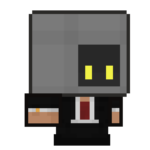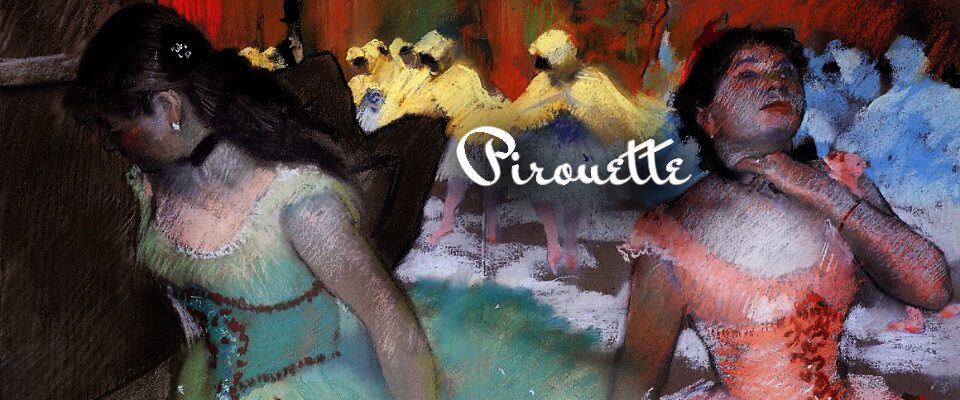Pirouette is a solo horror tabletop game and the origin title for the Standing Ovation SRD. In Pirouette, you take the role as a ballet dancer, performing a solo that could make your career, or end your life at the hands of the amorphous, eldritch Audience. It is the work of Michael Sweeney, aka InnocentGoblin, with layout edits by Seb Pines.
I’ve been following InnocentGoblin’s work for about half a year now, especially early in Pirouette’s development. From the start, I was intrigued as someone with strong ties to the dance world through family and friends. This game presents a unique horror from the tagline, blending stage fright and the pressures of perfection and performance, especially in such a rigid form such as ballet.
“The plié is a fundamental. The first a new dancer would learn, from a time when things seemed so simple. When dance was fun, a way to burn energy and express oneself. Before the nights of icing joints, studying form and burning routine and perfection into the folds of one’s brain until the neural endings were fried.
The plié is second nature. It allows the mind to wander, to the friends lost in exchange for late nights studying. To the other passions that could never shine as bright. The narrowing of the roads to this one end goal. There is nothing else. Every other shred of a life was spent in the churning pursuit of this one dream.”
Pirouette had a successful crowdfunder earlier this year, raising £843, 422% over their initial fundraising goal of £200.
InnocentGoblin did reach out publicly on Bluesky for reviews, and I did accept, but as with my review for Blood On Your Name, I am not being monetarily endorsed to review this. This disclaimer is nothing more than transparency, and I only accepted because I want more people to play this cool game.
Design & Layout
If the initial premise of Pirouette didn’t sell me, then the gorgeous paintings featured with the crowdfunded release did. From a distance, these impressionistic paintings make sense, ballerinas in their tutus and dresses dancing on stage with rosy red lips and perfect form.
But as you peer closer, start to actually perceive the paintings, you notice the man in a starkly dark suit standing off to the stage right doesn’t have a face, obscured by the setting props. The ballerina behind him in the sickly yellow tutu doesn’t have a head, just an exposed neck where the brushstrokes stop.
Through some digging online, I uncovered the artist behind these surrealist works. Edgar Degas was a 19th century impressionist artist. Born and died in Paris, Edgar made over 600 artistic works which now reside in the public domain, including a majority (if not all) of the artwork featured in Pirouette.
From examining pieces of his collection, his loose, impressionist style most likely comes from painting on location, as ballet dancers actively perform, resulting in the blurring of limbs, missing pieces and a loose, flexible brushstroke style. Some pieces are identical, with a sepia rough sketch and a colourised, more refined copy.
Edgar Degas’ work balances a fine line between a haunting uncanny valley, and the light and whimsical. It works perfectly for Pirouette, to a point where I hadn’t even questioned if the art was purposefully made for this game. It’s a high praise to make public domain art work so well and so cohesively.
Seb Pines did a fantastic job on the layout, with the coloured watercolour splashes, the typefaces, and the tactical use of the colourful, vibrant art pieces and negative space, Pirouette was a delight to read through and easy to navigate during playtime.
Mechanics in Pirouette
Pirouette is the first game in the Standing Ovation SRD. It utilises both a block tower and a tarot deck with major and minor arcana. What caught my eye is there’s no player control over the resolution mechanics, the most a player can get is reorganising the cards for their routine, by which every other card draw is compared again.
The aim of the game is essentially to pass, on average, 7 skill checks in a row by drawing cards with a higher value than the corresponding routine card. Doing this ensures your character succeeds in the ballet move they had to perform, failure can lead to exhaustion, or worse: injury, which can impact what ending you get (if you survive the routine).
Your exhaustion is ever-present through your playthrough and determines how many blocks you draw from your block tower at the end of each turn. If the tower collapses, so does your character as they find themself unable to push on. Injuries add to how many blocks you pull from the tower on that turn, and more severe injuries can increase your exhaustion on top of that.
Minor arcana cards merely determine whether you pass the check or not by comparing the values to the routine card. If you draw the same suit as the routine card, you don’t need to pull blocks for Exhaustion.
Major arcana cards, while also checking to see if the move is successful, have prompts attached to them as well. These represent the character’s mind drifting, reflecting on everything that brought them to this point.
Major arcana cards can be drawn upright, or reversed, with a prompt for each. I didn’t know this until after I shuffled, so I used a coin flip to determine which prompt to follow. (Heads = upright, tails = reversed). Only minor arcana cards are drawn to make the initial routine.
It wasn’t clear how to compare the Aces, Pages, Knights, Queens and Kings to how I may have passed the skill checks, so I treated them as 1, 11, 12, 13 and 14, which made logical sense, but some clarification here would have been nice as well.
As this was my first game using a tarot deck, and having never even touched one before, I would have appreciated some explanation of the difference between major and minor arcana. I could figure it out through some google searches, but a quick sentence or two elaborating could go a long way.
Another issue I can address is: in traditional block tower games like Jenga, when a block is removed, it is placed on top of the tower. But I have seen interpretations where people place the block to the side instead. Often, these solo games don’t mention placing the blocks back atop the tower, or to the side, and often I end up feeling like I’m making a vague guess on the play intentions.
All that said, I still had a delightfully suspenseful time with Pirouette and encountered some tense moments where I thought my ballet dancer wouldn’t get out alive.
Conclusion
“A final breath, a polite smile as Maria sweeps her leg, raises an arm, then takes a polite curtsy. All decorum, all smiles. But her weight is not on her sore foot. And no sooner does she rise, does that perfect smile crumble and an expression of disgust and contempt take its place. The Audience smiles and applauds, but they share in the disgust. Neither party is satisfied by the performance here. The Audience hungers, Maria lacked perfection.
Her mother waited in the lobby, but Maria ensured to waste no time dawdling in the accursed building. Instead, they retreated to the car, where Maria could ice her foot and take a moment of respite and ease. Already her phone was playing dance videos, desperate attempts to weed out the weak spot and cull it.
Nothing sacrificed is nothing gained. There is always greater to strive for. And when the Audience next demands her performance, she will be ready.”
Now that we’re 8 months into the year, I can safely say Pirouette is one of the best solo tabletop games I’ve played this year for the Wobble blog. And there have been some absolute bangers. From the personal ties, to the art direction, to the balance of tension and routine. Plus, you can never go wrong with some eldritch shenanigans.
It’s tactile, it oozes theme and atmosphere, the rulebook looks amazing, and I am so excited to see what InnocentGoblin has in store for What Haunts Us, coming later this year in October. I’ve already bought Be Still Archivist to tide me over in the meantime.
- Playtime: 2 ½ Hours
- This Game Is: Suspenseful, Beautiful & Thrilling
- Final Rating: 1 High Distinction
More from the Team Behind Pirouette:
- Get Pirouette Here
- InnocentGoblin’s Itchio
- InnocentGoblin’s Bluesky
- Check Out the What Haunts Us Quickstart
- Seb Pines’ Bluesky
(It/They/Him)
Independent Game and Graphic Designer based in Australia.
I make physical tabletop games, primarily roleplaying, but I haven’t shied away from card games in the past.
My main focus now is solo games, both playing, creating, and reviewing.

